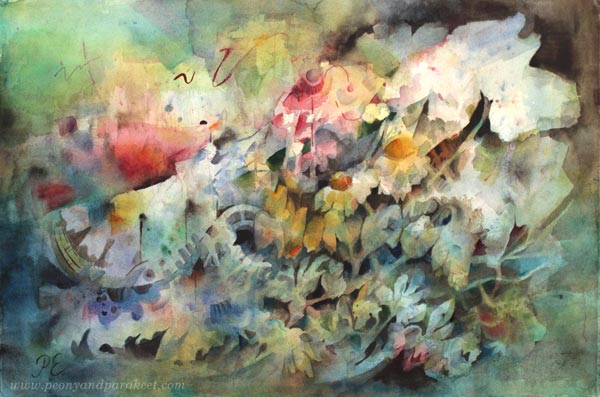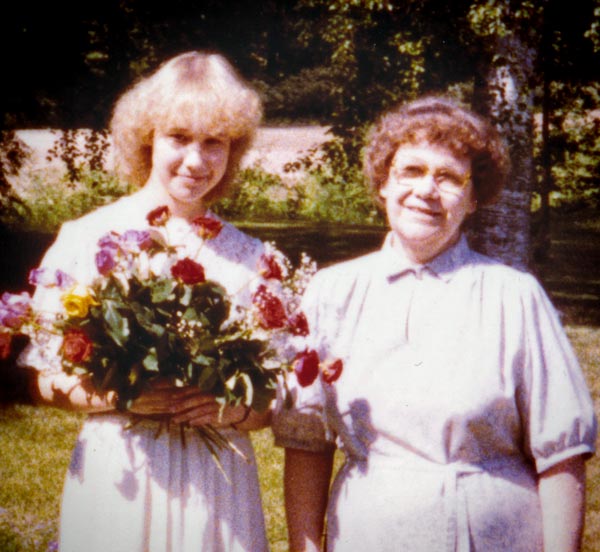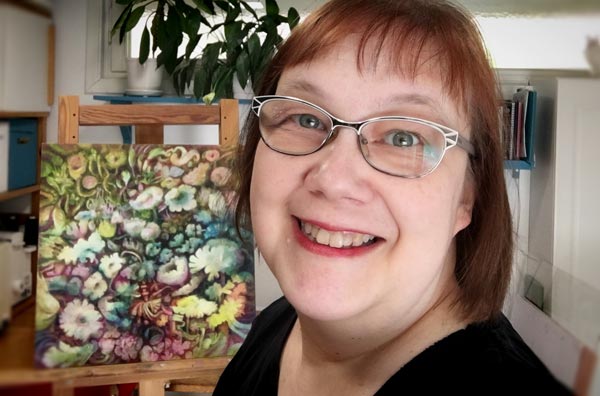There’s a lot of talk about finding your artistic voice, but very little about how other people affect it. So this week, I share a story about my mother and her influence on my art.
Painting the Same Thing Again and Again
A couple of days ago, I was on a morning walk near my home in Southern Finland. The air was fresh as well as the view, dominated by the blue sky and white clouds. My beagles’ busy noses and a glimmering brook followed a sown field that had already started to green. Both birds and earphones fed entertaining listening. But all I could think of was my painting. Was it finished? Should I add more color to the flowers? What else did I need to adjust to make most of the tens of hours? I was alone with my dogs, but the inner critic kept me company: what kind of artist doesn’t even know the meaning of her images?

Yes, I am no artist at all. I paint white flowers, the easiest anyone can imagine, and the worst that my mother knew. “No white flowers,” she repeated to my father when her wedding anniversary came close, and he was about to buy a bouquet. “White flowers mean death.” And now, long after she has passed away, all I want to paint is white flowers.



Commenters are Your Art Coaches
Rebelling had no place in my upbringing during the 1970s and 1980s. As a teenager, I tried to respond to my mother’s corrections and criticism with an ignorant smile. Not for long. She didn’t hesitate to tell that it wasn’t a proper reaction. She was both a direct and shy person. Her presence was almost invisible in public gatherings, but at home, in her empire, she was the master of rights and wrongs. So when I showed drawings to her, she either approved or disapproved. She didn’t talk to me as directly as to my father – what to do or what not – but her words and facial expressions told everything.
My mother was like a strict gymnastic coach with high expectations, but she lacked one essential skill – the ability to show how the tricks could be done. She was as honest to herself as to anyone in this matter and put her energy for finding time, supplies, and art education for me. Time to create was the easiest part. My mother was a housewife. She had left her job at a young age right after she got married. She didn’t want her daughters to have the same destiny, so she did her best to keep me out of the kitchen and constantly reminded me how children would prohibit me from doing what I love.

We lived in a small town near the Russian border, and our family wasn’t wealthy. The only income came from my father’s pension. In the evenings, my mother wrote all the expenses on a small black book. But purchasing pens and paper was mandatory. To her, it was the lowest level of civilization, more important than books. Our town had one bookshop that sold some supplies, but after we got more knowledge from local art groups and competitions, it became evident that I needed a better and broader selection. So every month, when my parents drove to a bigger town, I was often with them, selecting paper, paint boards, crayons, and acrylic paints from a real art supply store.
A Praised Piece Sticks into Your Mind
When I was some years over ten, in one spring morning, I decided to try out a new set of crayons. It was just a warm-up, a quick landscape without using any reference. “Look, mother, what do you think,” I said like so many times before. She looked at the image, tightened her lips, but unlike her, she didn’t say much. Later, when I opened a narrow kitchen closet to pick an iron, I stopped. The landscape was taped inside the wooden door. “I like to look at it,” she said after seeing my puzzled face.

I was devastated. That little landscape didn’t deserve the place. So many times I had poured my heart out on paper and soon found out that it wasn’t to her liking. And now – I didn’t even color all the paper!
Finding the Why Behind Your Artistic Voice – Connecting the Appraisals and Repetitions
Fortunately, my mother was not the only one commenting on my art. My two big sisters had different opinions, and my teachers and friends as well. One piece didn’t satisfy them all, but there were always kind words from someone. It encouraged me to keep painting and drawing, as everyone, especially my mother, expected.
After my mother’s death, one stormy weekend, I traveled to the childhood home to pick things that I wanted to keep before we would sell it. The house was cold, but I knew it was the last time when I would see it like it used to be. Everything was clean and tidy. Performing tasks effectively with high quality had always fascinated my mother. “If I could choose what my profession was, it would be a researcher of work – if such a profession existed.”
When I got up the stairs to an attic, the sight would surprise anyone but me. The attic had always been nearly empty. In one corner, under a sloped sealing, my father had built a small closet for safe storage. I opened its little door, and there they were, neatly in a big cardboard box – my paintings and drawings. Not all, but a collection that my mother had curated over the years, the little crayon drawing included.
So a few days ago, when I was walking by the field and looking up in the sky, my mother came to me in the form of the freshly colored landscape. I now knew that my urge to paint white flowers hadn’t been an act against my mother, but a yearn for her acceptance that blank white blobs had once given to me. Now my question is: can I let go of them, or do I want to keep her in my art forever.

Who has influenced your art? Can you recognize how?
P.S. I also teach drawing and painting flowers in the class Floral Fantasies.

To me the white is a resting place – like bright sunlight splashes on leaves. It gives me time to wander about the painting to see all the colors and textures . It feels like I’m looking through a sunlit woods, peering into the dense, shaded backgrounds to find the beauty spots of color. To me, your white is peaceful, comfortable, and happy.
Thanks so much for your beautiful description, Mary!
I really enjoyed that glimpse into your personal life, hearing about how your mother influenced your art. I find it both courageous and generous for you to share personal stories like that. Interesting and inspiring! Thanks.
Thank you, Stephanie!
I think the white flower examples that you are showing us here are shaped beautifully, organic, alive, emotional and unique.
Thank you, Wendy!
I loved the story about how you connect to your mother, my mother loved butterflies, so whenever I see one, I think of her.
Thank you, Joan, also for sharing a story about your mother. Does your art have butterflies, I wonder!
Thank you for sharing your very heartfelt story! I look at all of your paintings and I can’t even imagine how you do them! They are absolutely fascinating and glorious! I love all of the flowers, by the way!
Thank you, Karyl!
Hello Paivi, my own mother would not allow white flowers into our home. She said they meant sickness. I still get concerned if someone gives me flowers and white ones are mixed in the bunch! It is crazy, but that is the way it is. Thank you for the story of your early days. I see you have a strong resemblance to your mother.
Thanks, Maria, I totally get the feeling when someone gives a bunch mixed with white!
That is a beautiful story. I love white. Black always reminds me of death and white the eternal glory I hope to find someday in heaven. I love your story and work. It fascinates me. I’ve love to draw since I was able to remember. My father and grandfather encouraged me and wanted me to keep at it. Now, if I could only discover the way I want to paint. I am trying all styles and the abstract style interests me the most. You inspire me every time I watch your videos. I watch them over and over.
Thanks so much, Phyllis! The encouragement that we get as a child carries a long way!
Such appreciation for sharing a piece of your life again, Päivi! So this time, you take us back to your childhood and you are exploring your relationship with your mother. I think it is so important to relate our lives to others in any way we can–and through any of the arts! I wonder, if by the painting of white flowers, you are somehow trying to show her that you have discovered your “self”, and it is not exactly the one she always expected? Just a thought. I believe as you continue your paintings, the real “you” will reveal itself, more and more.
I too longed to be an artist when I was young and was certainly encouraged by my parents; but sadly, they did not think to keep my youthful drawings and paintings…however, I kept so many of my children’s art work and plan to incorporate some of it into my art. Especially important to me, since my son has died.
Thank you!
Thank you for your comment, Louisa! I think it’s a wonderful idea to get inspiration from children’s drawings. It would also be a beautiful tribute to your son. A Dutch abstract artist Karel Appel has done that, and as a teenager, I also tried that approach a couple of times. https://en.wikipedia.org/wiki/Karel_Appel
Loved your testimony about your Mom. Deep down inside she was very proud of
your art work or she would have never saved them.. Every color has its place I feel. Enjoy your art work…
Thank you, Donna! Yes, I think my mother was proud, and definitely every color needs a chance!
Thank you for sharing this wonderful story of your childhood. Think that smooch of who we are and what we pass along to our children is influenced by those early days and relationships. I love your white flowers and your tender attention to negative space. As many have written, Rilke and Leonard Cohen among them, the wound/crack is where the light comes in.
Thank you for the lovely comment, Stephanie!
Oh my gosh Päivi, what a bittersweet and emotional story! You have such an interesting way to draw all your threads together for a conclusion–whether it is on paper, or through your voice.
Thanks so much, Heather! When working with data systems, my role was often integrator and many of the projects were about integrating many systems to work together. So that may have affected to my art (or vice versa).